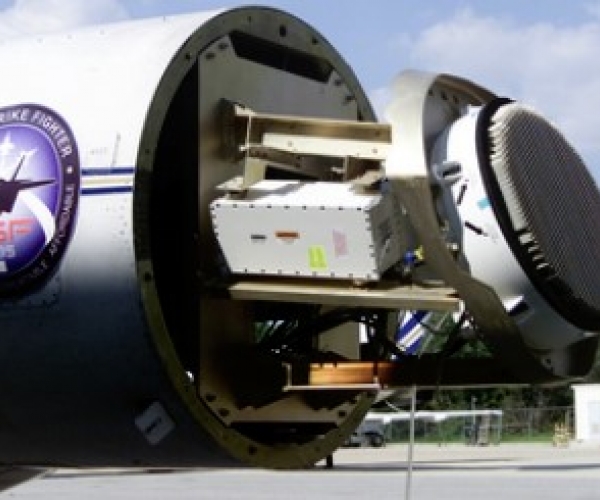AESA Radars Become Mainstream In Fighter Aircraft

Defense and aerospace firms around the world are investing on the development of Active Electronically Scanned Array (AESA) radars to replace mechanically-scanned radar systems in fighter and attack aircraft.
Defenseworld.net checks out the various technologies employed in AESA radars and lists out the differentiating factors between each of them.
For multirole aircraft such as the F-15E, F-16E/F and F/A-18E/F/G, the AESA radar can act both as an electronic attack weapon and an electronic counter-counter measure. The power and agility of the AESA’s beams can be used as a weapon, jamming or even frying out enemy radars.
Now the advanced version AESA radar is being used on fighter aircraft, such as F-22, F-35, Rafale, to name a few, where the radar frequency operates in a wide band signal.

America’s newest stealth fighter, F-35 Lightning II aircraft’s AN/APG-81 AESA radar installed in the nose, provides a unique protective sphere around the aircraft for missile warning, navigation support and night operations. The F-35's approach to radar-absorbent material (RAM) is more reliable than that of any earlier warplane.
The AN/APG-81 AESA is built to do more than scan—it can reach out to enemy radars and scramble their signals. A combination of radar and electromagnetic warning sensors alert an F-35 pilot to the threat of enemy radar; he can then dodge the threat or use the AESA to jam the signal, no matter what frequency the radar is transmitting.
And, if a missile is launched, the F-35 can track it with 360-degree infrared-sensor coverage and then, in some cases, overwhelm the missile's guidance system with the AESA.
But due to software issue with F-35 radar, the aircraft is accused of being more vulnerable to detection than earlier stealth aircraft, such as the F-22 Raptor, due to its more conventional airplane shape. When compared with Raptor, F-35 lacks a radar-shunting curve which is required to help mask it from enemy radar at all angles.
Other US aircraft - F/A-18, EA-18G and F-15, have Raytheon’s Advanced Combat Radar (RACR) technology installed. It has 5 to 10 times more operational availability than MSA radars and can simultaneous detect, identify and track multiple air and surface targets.

Russia is also designing and selling radar technologies. At present, it is developing a photonics-based radar system using active radio-optical phased array technology (known by its Russian acronym ROFAR) for its fifth-generation PAK FA fighter jet.
The transmission frequency of a modern radar system is at most 10 GHz, and with ROFAR it can reach 100 GHz. According to developer KRET, the future radio-optical phased array antenna known as ROFAR will be half the weight of the conventional radar system. At the same time, its resolution will be 10 times better.
Russia’s only fighter mounted AESA radar, the Zhuk-AE, contained 652 T/R modules and was unveiled in 2007.
Installed in MiG-35, Zhuk-AE can detect aerial targets at ranges up to 130 km (head on) in both look-up or look down modes. Look-up tail-on detection range is 50km (40km look down). The radar can track 30 aerial targets in the track-while-scan mode, and engage six targets simultaneously in the attack mode.
The radar provides target designation data for various Russian made missiles such as the R-27R1(R1E0, RVV-AE, R-73E, Kh-31A, Kh-35E and R-27T(TE) missiles. This radar was developed with modular approach, enabling upgrading existing Zhuk ME/MSE radars, into the phased array equipped MFE/MSFE standard, deployed in MiG-29/Su-27 platforms.
Sweden’s Gripen E aircraft has SELEX Galileo Raven ES-05 AESA radar that can be mounted on a “repositioner,” a rotating mount that gives the radar a ±100-deg. field of view around the nose. The AESA provides virtually instantaneous beam-steering within its ±70-deg. scan, but the repositioner is slower. It offers maximum situational awareness and enables the aircraft to turn away after missile launch, while maintaining datalinks to the missile.
Last year, SAAB unveiled the PS-05/A fighter radar to a new version designated Mk4, which gives Gripen C/D improved performance and operating range.
The Mk4 modification involves the replacement of two line-replaceable units in the back section of the mechanically-scanned radar. This provides a new exciter/receiver module with digital waveform generation and a new radar processing unit, along with updated software.
But the C/D-version fighter cannot currently be equipped with an active electronically scanned array (AESA) radar, without first requiring major structural modifications to accommodate systems to provide increased power and cooling capacity.

Thales last year delivered new RBE2 active electronically scanned array (AESA) radar for France’s Rafale fighter, replacing the passive array in the RBE2. It has the range extended by over 50% for future compatibility with new weapon systems like Meteor, and supports low-observable target detection enhancing the situational awareness during the ISR missions performed over the battlefield.
The RBE2 AESA provides +/- 70 degree azimuth and elevation coverage in comparison to RBE 2 pesa +/- 60 degree azimuth and elevation coverage. But the limitations of this radar is that it has a limited angular coverage (foV) due to its fixed aesa plate design compare to Swashplate aesa radars which have wider angular coverage (FoV).
The Rafale cannot maneuver more than 70 degree from the viewing angle in comparison to swashplate AESA radar planes (Eurofighter Typhoon, F-15C Eagle) which have more than 90 degree FOV.
But when compared with the US APG-80 AESA radar which has slightly higher detection range – about 10%, RBE2 AESA can lock maximum no of aerial targets.









